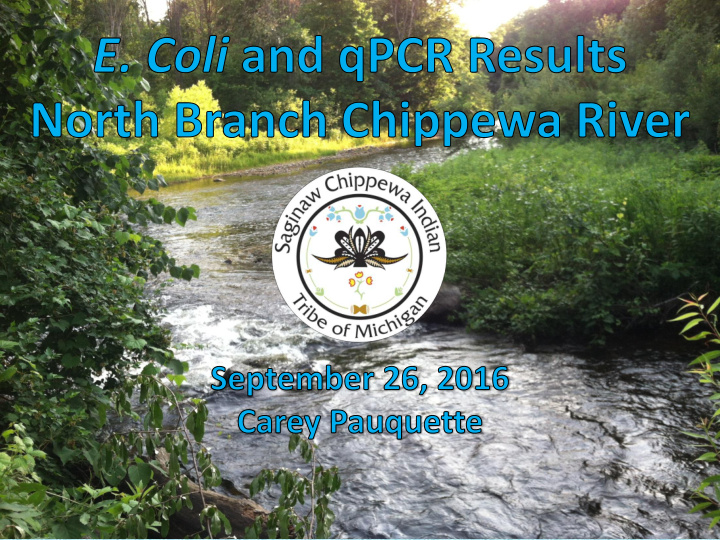



Why We Monitor • Protect the community • Identify issues to improve human health • Tribal programs are equal to the State through US EPA
What We Monitor • Physical Parameters • Nutrients • BioAssessment • Aquatic Insects • Velocity • Pathogen presence quantity Chippewa River at Meridian Park
What is E. coli ? • Escherichia coli (E. Coli) is an indicator of fecal contamination (animal digestive bacteria) • Fecal contamination contains harmful pathogens
What are the health effects of exposure to harmful fecal pathogens? • Digestion of contaminated water – Intestinal illness – Cramps – Fever – Nausea – Diarrhea • Contact with contaminated water – Infections of skin – Infection of ears – Respiratory illness – Eye infection – Neurologic impacts – Infection of wounds
Results Creating Concern 2015 2016
Need for Source Identification • The Problem : – Consistent exceedance of Human Health, Water Quality Standards set by the State of Michigan – Human Health concerns over multiple years Chippewa River sites largely exceed the State of Michigan reference standard of below 130 MPN/100ml, the threshold for the E. coli Daily Geometric Mean (monthly average) for full body contact in warm water streams. • Identification of the source to determine solution(s)
How can fecal contamination get into our waterways? • Animal fecal matter, including wildlife • Runoff from agricultural fields • Direct sewage discharges
Source Tracking Study Objectives: • Pathogen tracking in the North Branch of the Chippewa River Watershed • Trace high levels of E. coli • Determine whether sources of E.coli are human, bovine, or another source • SVSU – DNA • Environmental Canine Services (ECS) – sent tracking human waste
Source Tracking Study Project Elements: • Identified areas of elevated levels of E.coli • Sent water samples for Ship and Sniff study • Evaluated results of Ship and Sniff • Conducted field investigations • Determine the accuracy and reliability of positive canine alerts with E.coli and DNA analysis. • The SCIT processed the E.coli samples using the Colilert-18 Method • SVSU processed the DNA samples
Data and Results • Most sample sites exceeded the Michigan Water Quality Standard of 300 MPN for the Daily Geometric Mean • E.coli levels were highest at the storm drain sites at the corner of Beal City and Winn Roads(BCD or BC) and Fitch Drive, reaching over 20,050 MPN • A creek that drained to the North Branch (CRNB2) also had noticeably elevated levels of E.coli.
Data and Results • Both Fitch Drive and Beal City and Winn Roads storm drains (BCD or BC) tested positive for human waste utilizing canine investigation and qPCR, DNA analysis • The creek that drained into the North Branch (CRNB2) tested positive for bovine waste.
Conclusions • Tribal studies have determined there is a human health threat risk. • The elevated E. coli readings are primarily a direct result of human waste. • Waterways impacted – North Branch Chippewa River – Main Branch of Chippewa River – Saginaw Bay
Recommend
More recommend